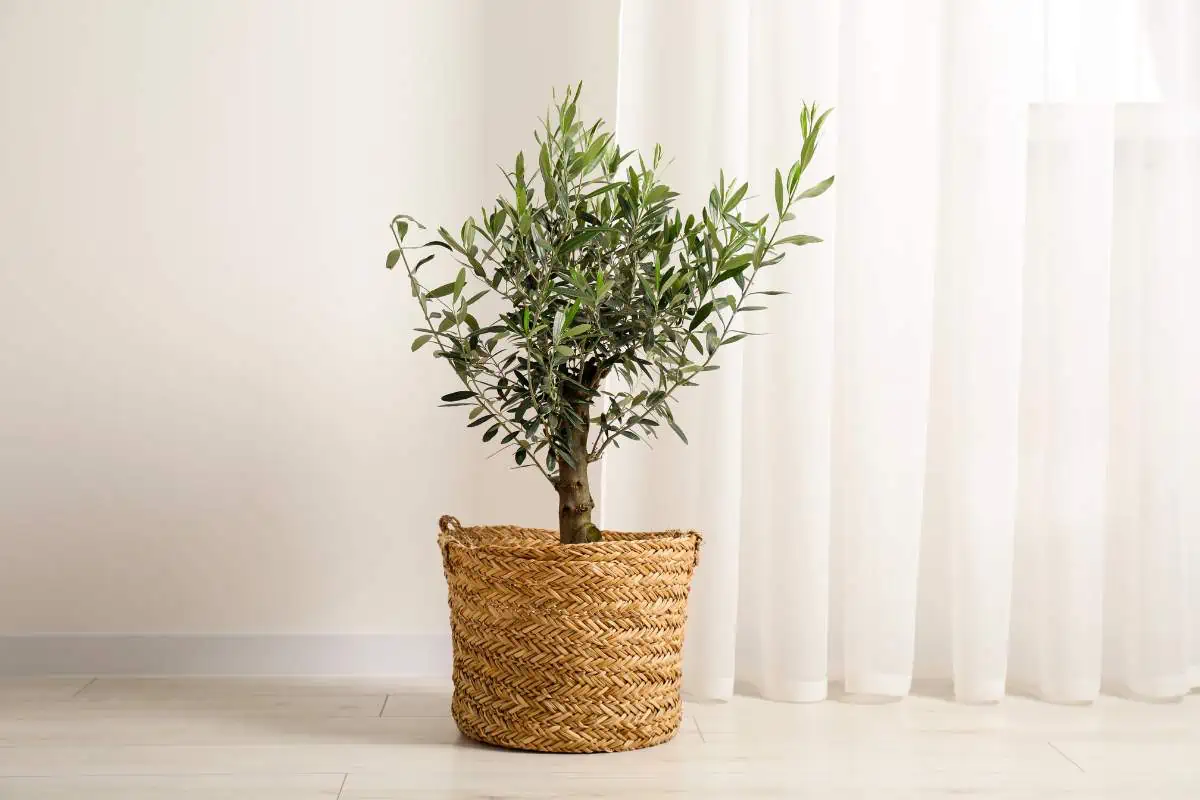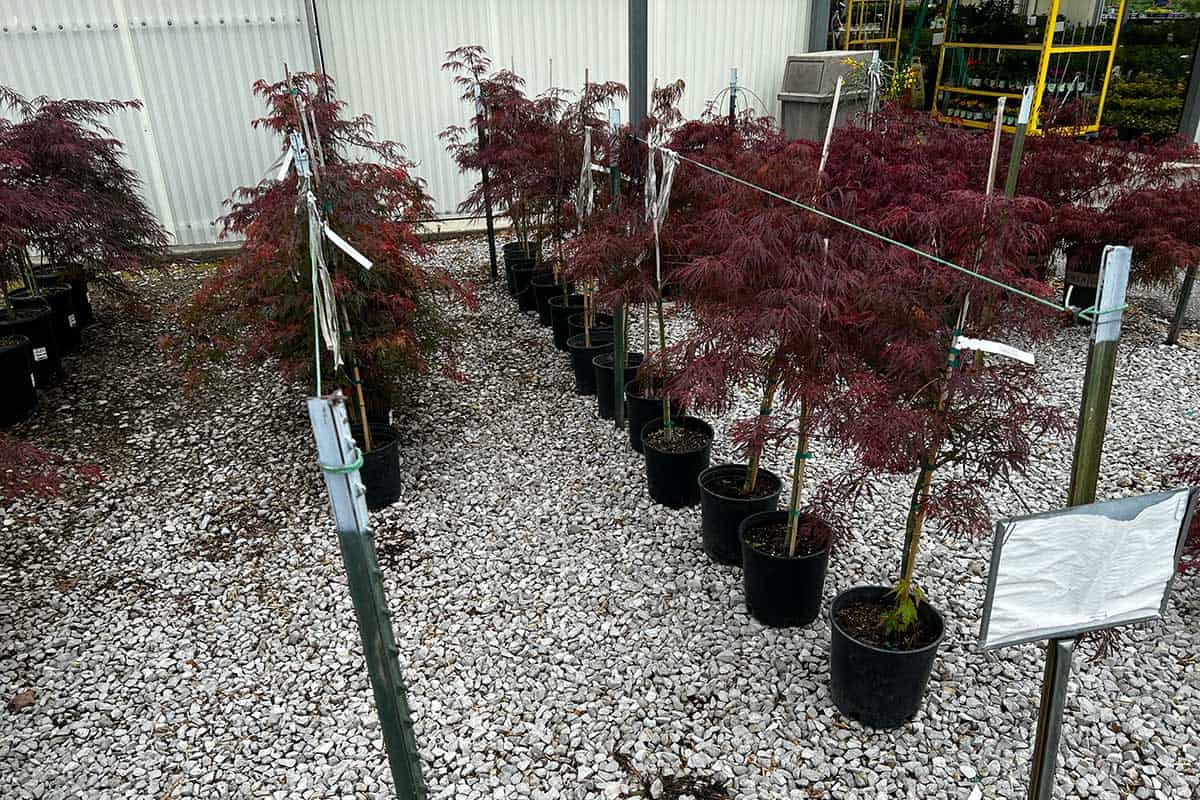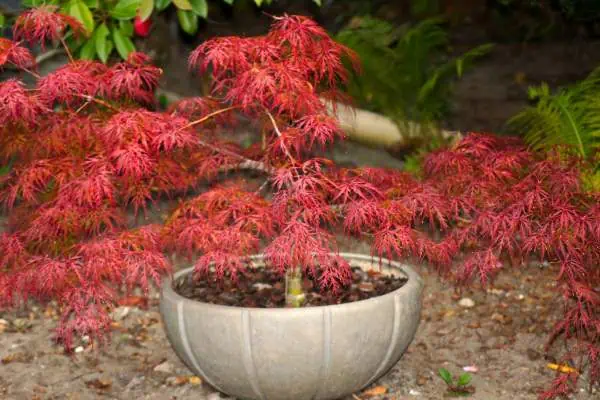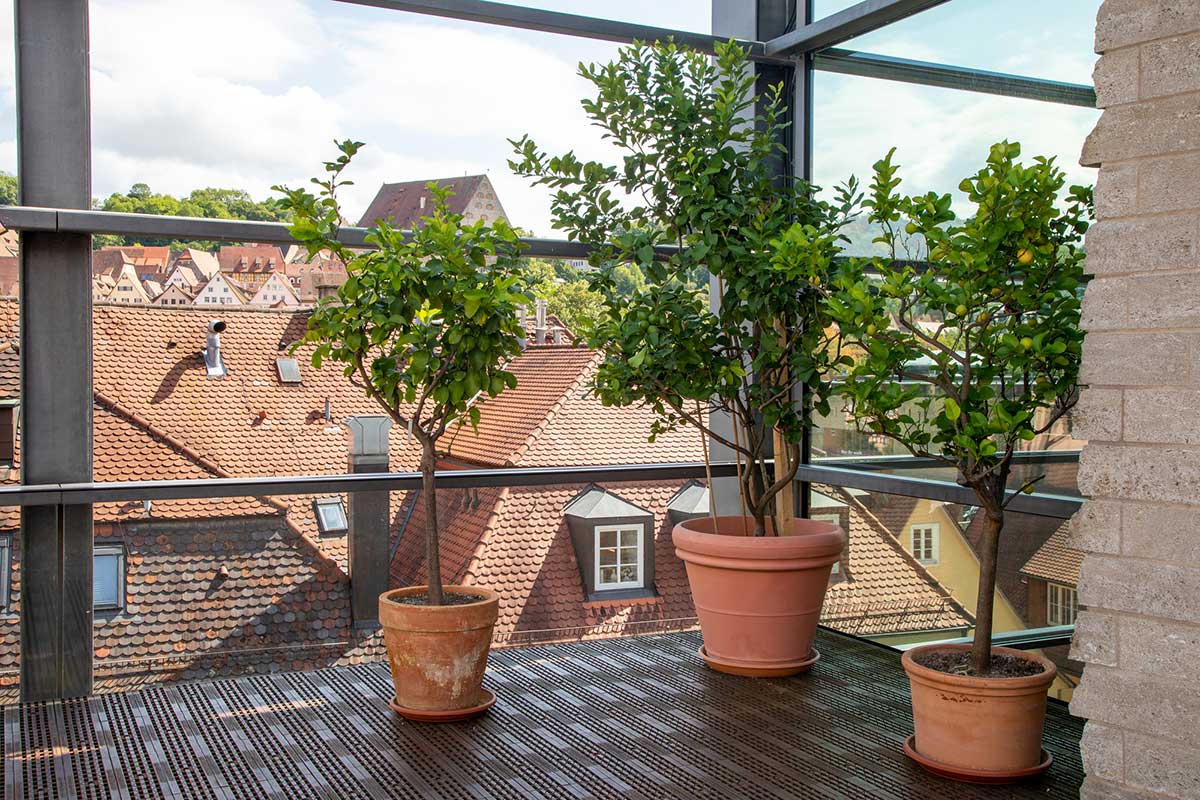Growing trees in pots offers numerous benefits, including added beauty, compactness, and versatility. If you grow the right trees, you can transform your patio, deck, or balcony into a lush, serene oasis. In this article, we will discuss some of the best trees that thrive in pots, as well as tips on choosing the right container size and ensuring proper care for your potted trees.
When selecting trees to grow in pots, look for small or dwarf species that won’t outgrow their containers too quickly. Some top choices include Japanese maple trees, dwarf cypress trees, yew trees, mountain pines, and Chinese junipers. These trees not only boast stunning foliage and textures but also adapt well to life in a container.
The size of the container plays a crucial role in the success of your potted tree. Make sure to choose a pot that corresponds to the tree’s mature size and allows ample room for root growth.
A well-draining container is essential to prevent excess moisture from causing root rot, so opt for pots with drainage holes and use a suitable potting mix for the tree species you’ve chosen. With proper care and attention, your container garden will flourish, providing a picturesque focal point and a relaxing retreat for you to enjoy.
15 Best trees to grow in pots
When looking to add greenery and beauty to your home through container gardening, it’s essential to choose tree species and varieties that are well-suited for growing in pots and containers.
1. Japanese Maple
Scientific name: Acer palmatum
Japanese Maple is a popular ornamental tree known for its diverse and colorful foliage. Many varieties of this tree are suitable for container growing, such as ‘Bloodgood’, ‘Sango-kaku’, and ‘Shishigashira’.
They are well-suited for containers because they have a shallow root system and grow relatively slowly. Japanese Maples are also highly adaptable to different soil types and can tolerate partial shade, making them ideal for a variety of settings.
When grown in containers, Japanese Maples require regular watering and well-draining soil to avoid root rot. They also benefit from annual pruning to maintain their desired size and shape. With proper care, these trees can provide year-round interest, as their leaves change color throughout the seasons.
2. Olive Tree
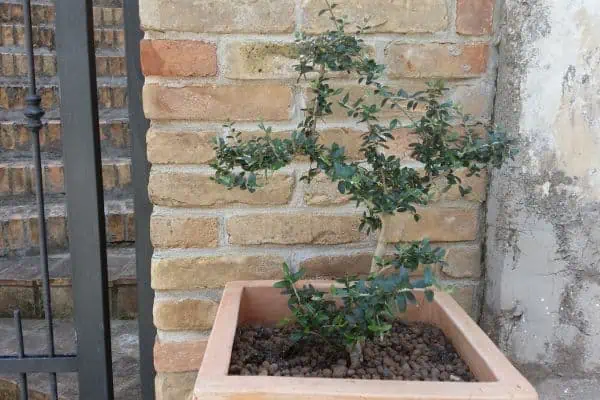
Scientific name: Olea europaea
Olive Trees are a classic Mediterranean choice, and the dwarf varieties like ‘Little Ollie’ and ‘Picholine’ are ideal for container growing. These trees have attractive, silvery-green foliage and can produce small, ornamental fruits. They are well-suited for pots because they are drought-tolerant and adapt to various soil conditions. Olive trees prefer full sun, making them a great choice for sunny patios and balconies.
In container culture, Olive Trees require proper drainage and a well-draining potting mix to prevent root rot. Pruning is essential to maintain the desired shape and size and to encourage fruit production. Additionally, the trees may need protection from frost in colder climates, which can be more easily managed when grown in containers.
3. Citrus Trees
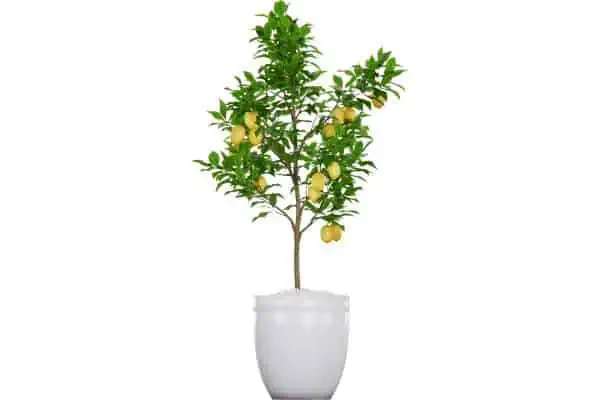
Scientific name: Citrus spp.
Dwarf citrus trees, such as ‘Improved Meyer’ lemon, ‘Calamondin’ orange, and ‘Bearss’ lime, can thrive in pots. These trees not only provide beautiful evergreen foliage but also produce fragrant flowers and edible fruit. They are suitable for containers because they can be pruned to maintain a compact size, making them perfect for small spaces.
When grown in pots, Citrus Trees require well-draining soil, consistent watering, and regular fertilization with a citrus-specific fertilizer. They prefer full sun but can tolerate some shade. In colder climates, container-grown citrus trees can be moved indoors during winter, providing year-round enjoyment and fruit production.
4. Camellia japonica
Scientific name: Camellia japonica
Camellias are evergreen shrubs with stunning flowers that bloom in winter or early spring. Varieties such as ‘April Remembered’ and ‘Kramer’s Supreme’ are suitable for container growing. Camellias are a good choice for pots because they have a shallow root system and can be pruned to maintain a compact shape.
When grown in containers, Camellias require acidic, well-draining soil and consistent moisture. They thrive in partial shade, making them perfect for spots with dappled sunlight. Proper pruning and fertilization will ensure a healthy plant with abundant blooms.
5. Magnolia ‘Little Gem’
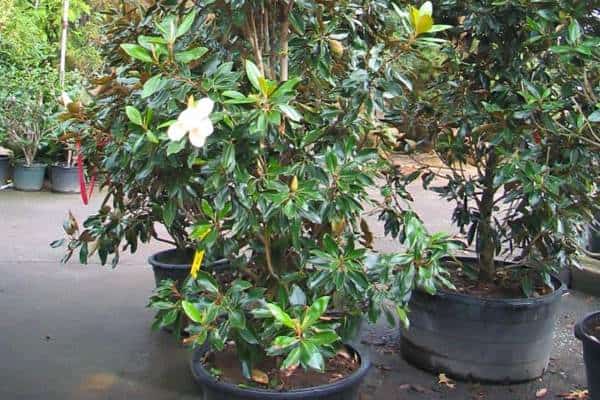
Scientific name: Magnolia grandiflora ‘Little Gem’
‘Little Gem’ is a smaller variety of Magnolia grandiflora, which is well-suited for container growing. This evergreen tree produces large, fragrant white flowers and has glossy green leaves with a rusty-brown underside. Its smaller size and slower growth rate make it an ideal candidate for pots.
In containers, ‘Little Gem’ Magnolia requires well-draining, slightly acidic soil and consistent watering. It prefers full sun to partial shade. Pruning can be done to maintain the desired size and shape, and it should be done after the tree has finished flowering.
6. Crepe Myrtle
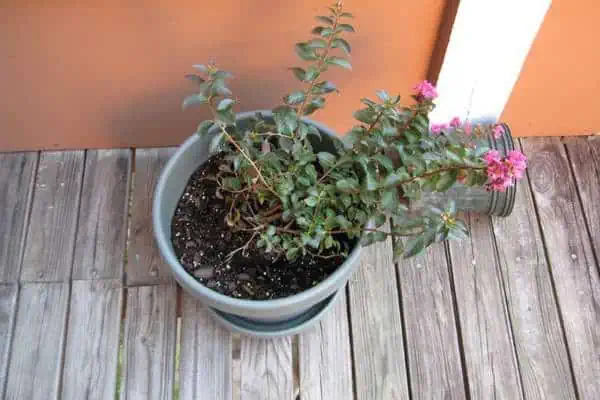
Scientific name: Lagerstroemia
Crepe Myrtles are known for their stunning summer blooms and attractive, peeling bark. Dwarf varieties like ‘Chickasaw’ and ‘Pocomoke’ are well-suited for containers. These trees are a great choice for pots because they are heat-tolerant, drought-resistant, and can be pruned to maintain a compact shape.
When grown in containers, Crepe Myrtles require well-draining soil and full sun exposure to encourage prolific blooms. Regular watering is essential, especially during the hot summer months. Prune Crepe Myrtles in late winter or early spring to promote vigorous growth and abundant flowering.
7. Dwarf Fig
Scientific name: Ficus carica
Dwarf Fig trees, such as ‘Petite Negra’ and ‘Little Ruby,’ are compact varieties that are perfect for pots. These trees produce sweet, edible fruits and have attractive, lobed leaves. Their small size and shallow root system make them well-suited for container growing.
In containers, Dwarf Fig trees require well-draining soil and consistent watering. They prefer full sun but can tolerate some shade. Pruning is essential to maintain the desired shape and size, as well as to encourage fruit production. In colder climates, container-grown fig trees can be moved indoors or to a protected area during winter.
8. Dwarf Asian Pear
Scientific name: Pyrus pyrifolia
Dwarf Asian Pear varieties, such as ‘Hosui’ and ‘Shinseiki,’ are suitable for container growing. These trees produce crisp, juicy fruits and have attractive, glossy green leaves. Their compact size and slow growth rate make them ideal for pots.
When grown in containers, Dwarf Asian Pear trees require well-draining soil, consistent watering, and full sun exposure. Regular pruning is necessary to maintain the desired size and shape, as well as to encourage fruit production. In colder climates, provide winter protection to ensure the trees survive and continue to produce fruit.
9. Dwarf Apple
Scientific name: Malus
Dwarf Apple trees, such as ‘Golden Delicious,’ ‘Gala,’ and ‘Cox’s Orange Pippin,’ are great container-friendly apple varieties. These trees produce fragrant blossoms in spring and edible fruit in fall. Their compact size and ability to be pruned make them suitable for pots.
In containers, Dwarf Apple trees require well-draining soil, consistent watering, and full sun exposure for the best fruit production. Pruning is essential to maintain the desired size and shape, as well as to encourage fruit production. In colder climates, provide winter protection to ensure the trees survive and continue to produce fruit.
10. Dwarf Cherry
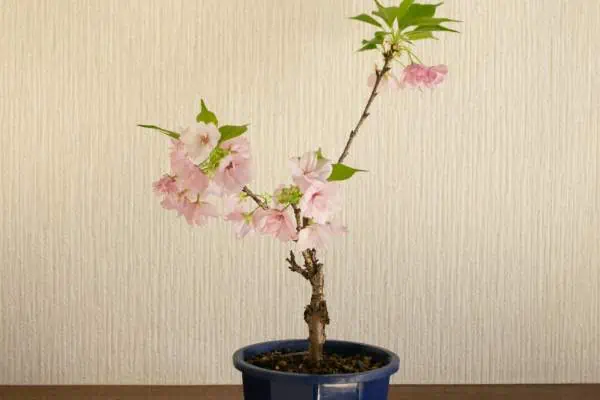
Scientific name: Prunus
Dwarf Cherry varieties, such as ‘Carmine Jewel,’ ‘Romeo,’ and ‘Juliet,’ are suitable for container growing. These trees produce beautiful spring blossoms and edible cherries. Their compact size and slow growth rate make them ideal for pots.
When grown in containers, Dwarf Cherry trees require well-draining soil, consistent watering, and full sun exposure for the best fruit production. Regular pruning is necessary to maintain the desired size and shape, as well as to encourage fruit production. In colder climates, provide winter protection to ensure the trees survive and continue to produce fruit.
11. Ginkgo ‘Mariken’
Scientific name: Ginkgo biloba ‘Mariken’
‘Mariken’ is a dwarf variety of the Ginkgo tree, known for its unique fan-shaped leaves that turn a striking golden-yellow color in the fall. This slow-growing, compact variety is perfect for container growing, making it an excellent choice for small spaces.
When grown in containers, Ginkgo ‘Mariken’ requires well-draining soil and consistent watering. The tree prefers full sun to partial shade and can tolerate a wide range of soil types. Occasional pruning may be necessary to maintain the desired size and shape. Ginkgo trees are also known for their resilience and ability to withstand urban environments.
12. Eastern Arborvitae ‘Teddy’
Scientific name: Thuja occidentalis ‘Teddy’
‘Teddy’ is a dwarf variety of the Eastern Arborvitae, a coniferous evergreen that makes an excellent container plant. Its compact, rounded shape, and soft, feathery foliage create year-round interest. This slow-growing variety is ideal for containers and small spaces.
When grown in containers, ‘Teddy’ Arborvitae requires well-draining soil and consistent watering. It prefers full sun to partial shade and can tolerate a variety of soil conditions. Occasional pruning may be necessary to maintain the desired size and shape. The tree is also deer-resistant, making it an attractive option for gardeners dealing with deer browsing.
13. Mugo Pine
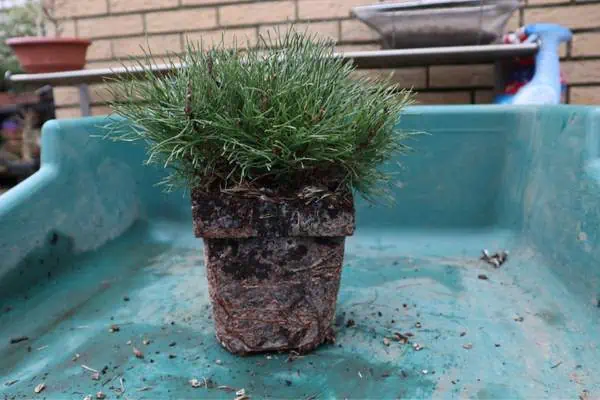
Scientific name: Pinus mugo
Mugo Pine is a slow-growing, compact conifer that is well-suited for containers. Dwarf varieties like ‘Mops’ and ‘Sherwood Compact’ have a dense, rounded form and dark green needles, providing year-round visual interest.
In containers, Mugo Pine requires well-draining soil and consistent watering. The tree prefers full sun but can tolerate some shade. Occasional pruning may be necessary to maintain the desired size and shape. Mugo Pine is also cold-hardy, making it a good choice for container gardening in colder climates.
14. Japanese Holly
Scientific name: Ilex crenata
Japanese Holly is an evergreen shrub with small, glossy leaves that resembles boxwood. Varieties such as ‘Helleri,’ ‘Sky Pencil,’ and ‘Soft Touch’ are well-suited for container growing. These compact plants can be pruned into various shapes, making them versatile for different garden styles.
When grown in containers, Japanese Holly requires well-draining soil and consistent watering. The shrub prefers full sun to partial shade and can tolerate various soil types. Regular pruning is necessary to maintain the desired size and shape. Japanese Holly is also deer-resistant, making it an attractive option for gardeners dealing with deer browsing.
15. Hinoki Cypress
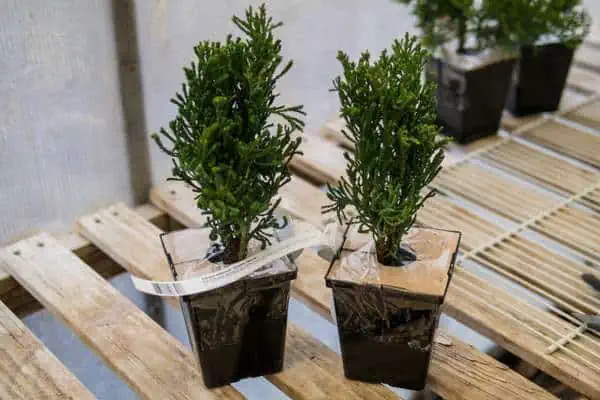
Scientific name: Chamaecyparis obtusa
Hinoki Cypress is an evergreen conifer known for its attractive, fan-like foliage and lemony scent. Dwarf varieties like ‘Nana Gracilis’ and ‘Verdoni’ have a compact, pyramidal shape and are ideal for growing in pots.
In containers, Hinoki Cypress requires well-draining soil and consistent watering. The tree prefers full sun to partial shade and can tolerate a variety of soil conditions. Occasional pruning may be necessary to maintain the desired size and shape. Hinoki Cypress is also deer-resistant and can be an excellent focal point in container gardens.
Selecting the Ideal Trees for Container Gardening
Consider Size and Growth Patterns
When choosing trees for container gardening, it’s important to select varieties with manageable mature sizes and appropriate growth patterns.
Some suitable options include:
- Japanese Maple: These trees have delicate leaves that turn stunning shades of red, orange, or purple each fall. Many cultivars are small enough to be potted and thrive in well-drained soil.
- Crab Apples: Producing lovely pink blossoms in spring and ornamental fruits in fall, crab apples are among the best trees to grow in pots. Plant them in pots that are approximately 12-15 inches (30-40cm) in diameter.
- Dwarf Citrus Trees: Oranges and lemons do well in pots, especially when grown in terracotta containers. These Mediterranean species require good drainage and perform well in porous pots.
Choose Trees with Attractive Features
Aim for trees that offer attractive features such as beautiful blooms, interesting foliage, or striking shapes:
- Crepe Myrtle: Hardy in USDA zones 7 to 10, crepe myrtle trees feature bright summer flowers and grow 25 to 30 feet in larger landscapes. However, smaller varieties reach only three or four feet tall and can be raised in large containers.
- Witch Hazel: Slow-growing at around 10cm per year, witch hazel trees are ideal for small gardens and containers. They grow best in sun or part shade and don’t require pruning.
- Conical Trees: Trees with conical shapes can add height and structure to your container garden. Examples include bay trees or dwarf varieties of spruce and juniper.
Factor in Growing Conditions
Lastly, consider the specific growing conditions, such as light and temperature preferences, when selecting your potted trees:
- Shade-Loving Trees: If your container garden is located in a shaded area, choose trees that thrive in low light, like Japanese holly or certain varieties of fern.
- Indoor/Outdoor: Some trees, such as citrus or fig, can be moved indoors during winter months for added protection against frost. Ensure you select varieties that suit your intended indoor/outdoor setup.
- Low Maintenance: Opt for hardy, perennial trees that require minimal care to thrive. Examples include evergreens or certain native species suited to your climate.
When planning your container garden, carefully consider the mature size of your chosen trees, their attractive features, and the growing conditions required for a successful, low-maintenance display. With thoughtful planning, you can enjoy the beauty and benefits of trees in any garden, regardless of space limitations.
Key Factors for Growing Trees in Pots
Select the Appropriate Soil
When growing trees in pots, it is crucial to choose the right soil type. Look for a soil mix specifically designed for potted trees or container planting. These mixes will provide the necessary nutrients and proper drainage for your tree.
Here are some soil selection tips:
- Opt for a soil mix rich in organic matter, such as compost or aged bark fines.
- Make sure the soil drains well to prevent root rot, but retains enough moisture for the tree’s roots.
- Consider adding perlite or vermiculite if your soil mix is too heavy.
Choose the Right Pot
Selecting the right pot for your tree is essential for its growth and health.
Consider the following when choosing a pot:
- Tree size: Ensure the pot is large enough to accommodate your tree’s root system as it grows. Dwarf or compact varieties tend to be better suited for container planting.
- Container size: Typically, pots should measure at least 12-15 inches in diameter for younger trees, and larger trees need a pot between 18-24 inches in diameter. However, consult your chosen tree variety’s specific size requirements.
- Material: Opt for a pot made of materials like terra cotta, ceramic, or wood, which can provide insulation from temperature fluctuations.
- Drainage: Make sure your chosen pot has ample drainage holes to prevent waterlogging.
Watering and Fertilizing Basics
Proper watering and fertilizing are essential when growing trees in pots.
Keep the following guidelines in mind:
- Watering: Trees in containers require more frequent watering than those planted in the ground. Check the soil moisture regularly, and water your tree when the top 1-2 inches of the soil feels dry. Take care not to overwater or underwater your tree, as both can be detrimental to its health.
- Fertilizing: Since potted trees deplete soil nutrients quicker than their in-ground counterparts, regular fertilization is necessary. Use a slow-release fertilizer designed for potted trees, following the manufacturer’s directions for application rates and timings. Be mindful of the tree’s specific nutrient requirements and USDA zones for optimal growth.
With these key factors in mind and attentive care, you can successfully grow trees in pots and enjoy their beauty in your outdoor space.
Best Trees for Autumn Color and Foliage
Growing trees in pots allows you to enjoy the beauty of autumn color and foliage even in small spaces. In this section, we will discuss four ideal tree choices for creating a stunning autumn display in your containers.
1. Japanese Maple (Acer palmatum)
- Scientific Name: Acer palmatum
- Tree size: Most Japanese Maple varieties grow 3m – 10m tall
- Container size: Minimum 45 cm in diameter
Japanese maples are renowned for their colorful foliage, which is especially striking in the autumn months. With a wide range of colors and growth habits, these maples are suitable for containers or small gardens.
In fall, the leaves of Acer palmatum change from shades of green to brilliant oranges, reds, and yellows, creating a stunning seasonal display. Make sure to place your potted Japanese Maple in a location where it will receive partial shade and protection from strong winds.
2. Crepe Myrtle
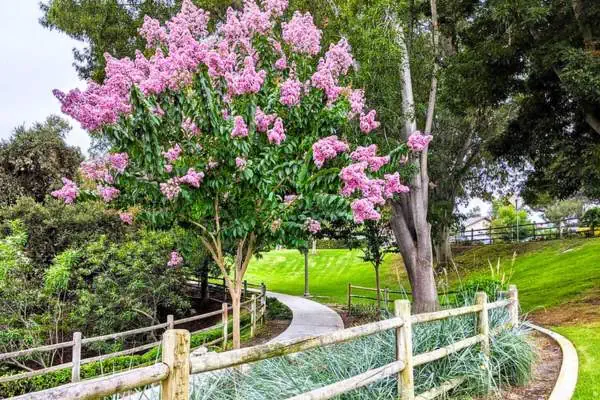
- Scientific Name: Lagerstroemia
- Tree size: 1.5m – 8m, depending on variety
- Container size: Minimum 45 cm in diameter
Crepe Myrtles are versatile trees with multi-season interest, providing colorful flowers in summer and vibrant foliage in autumn. The leaves of Crepe Myrtles change from green to vibrant hues of orange, red, and yellow in fall, creating a stunning contrast with their peeling bark. These trees thrive in full sun locations and well-draining potting soil.
3. Dwarf Alberta Spruce
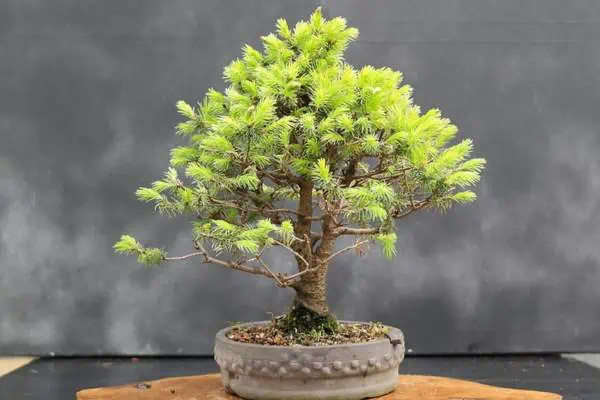
- Scientific Name: Picea glauca ‘Conica’
- Tree size: Up to 3m tall
- Container size: Minimum 30 cm in diameter
Dwarf Alberta Spruce is a slow-growing dwarf conifer, ideal for growing in pots and small spaces. Its soft, evergreen foliage provides year-round interest, while the golden tones of fall bring a subtle hint of color to the garden.
This low-maintenance tree thrives in full sun or partial shade and prefers moist, well-draining soil. Ensure your potted Dwarf Alberta Spruce receives adequate water during dry periods.
4. Juniper
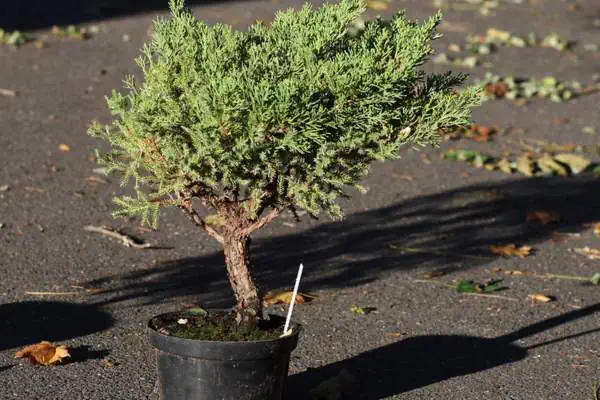
- Scientific Name: Juniperus spp.
- Tree size: 1m – 6m, depending on species and cultivar
- Container size: Minimum 30 cm in diameter
Junipers are hardy evergreen plants known for their unique foliage and interesting growth habits. Various species and cultivars exhibit contrasting shades of greens, blues, and yellows, providing color even during autumn.
Ensure your potted Juniper is placed in a location that receives full sun and is planted in well-draining soil to prevent root rot. With proper care, these hardy trees can provide year-round interest and a touch of autumn color to your container garden.
Evergreen Trees for Year-Round Interest
In this section, we will explore a few evergreen trees that are ideal for growing in pots, providing year-long interest in your garden.
1. Weeping Fig
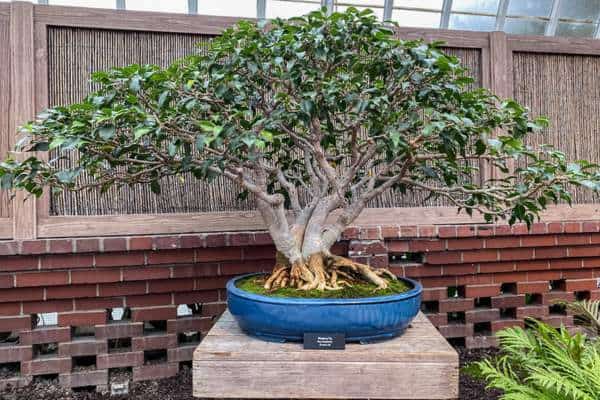
- Scientific Name: Ficus benjamina
- Tree size: 3-6 feet (in containers)
- Container size: At least 2-3 times the width of the root ball
The Weeping Fig is a popular evergreen tree that is great for pots. With its shiny, small leaves and gracefully drooping branches, it can create an attractive focal point in your garden. Ensure you place it in a bright, indirect light and provide consistent moisture to help it thrive.
It typically grows 3 to 6 feet tall in containers, making it suitable for small spaces.
2. Sweet Bay
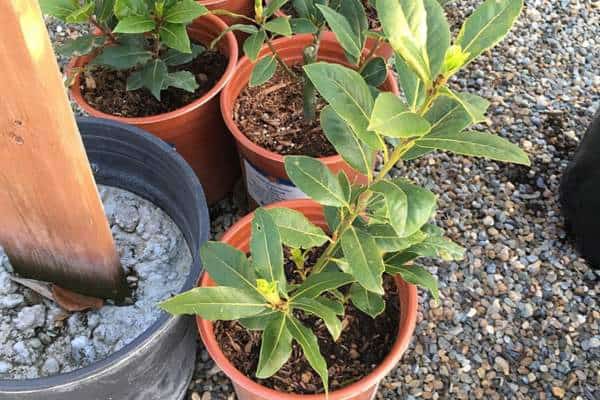
- Scientific Name: Laurus nobilis
- Tree size: Up to 12 feet tall (in containers)
- Container size: Large enough to accommodate the root ball but not excessively large to help regulate growth
Bay Laurel, aka Sweet Bay, is a versatile evergreen tree with aromatic leaves often used for culinary purposes. Perfect for containers, it can be trained into a topiary or pruned to maintain its shape.
Sweet Bay prefers full sun or partial shade and well-draining soil. It is best to keep the container on the smaller side for controlling its growth, as the tree may grow up to 12 feet tall.
3. Blue Spruce
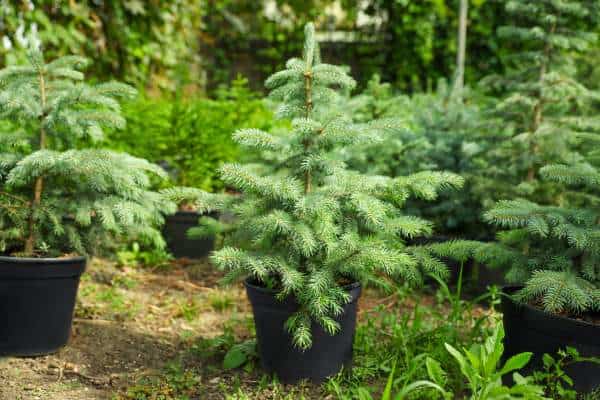
- Scientific Name: Picea pungens
- Tree size: 3-5 feet tall, 6-10 feet wide (in containers)
- Container size: 1.5-2 times the width of the root ball, with ample depth for root growth
Dwarf Blue Spruce is an eye-catching evergreen with stunning silver-blue needles, making it a great addition to your container garden. Thriving in zones 3 to 7, it prefers full sun and well-draining soil. Slow-growing and compact, this spruce can reach 3 to 5 feet tall and 6 to 10 feet wide in containers.
By choosing one or more of these evergreen trees for your pots, you’ll create a visually appealing and dynamic space that will capture attention throughout the year.
Fruit Trees for Container Gardening
In your quest for the best fruit trees to grow in pots, consider these top choices for producing delicious fruit in your container garden.
1. Peach Tree
Peach trees are ideal for container gardens as they can be easily moved to take advantage of the sunniest and warmest positions throughout the year.
To successfully grow a peach tree in a pot, make sure to:
- Choose a dwarf variety that is suitable for container growth.
- Select a well-draining pot that is at least 16 inches in diameter.
- Provide the tree with plenty of sunlight, as peaches require full sun for optimal growth.
- Water regularly, ensuring that the soil remains moist but not waterlogged.
2. Lemon Tree
Lemon trees are another excellent choice for container gardening. Their fragrant blossoms and citrus fruit can bring beauty and freshness to your space.
For the best results when growing a lemon tree in a container, consider the following tips:
- Opt for a dwarf or semi-dwarf variety, as these are better suited for pot growth.
- Select a pot that is at least 16 inches in diameter and has good drainage.
- Place the container in a sunny spot, as lemon trees require a minimum of six hours of sunlight each day.
- Keep the soil consistently damp but avoid overwatering, which can harm the tree’s roots.
3. Olive Tree
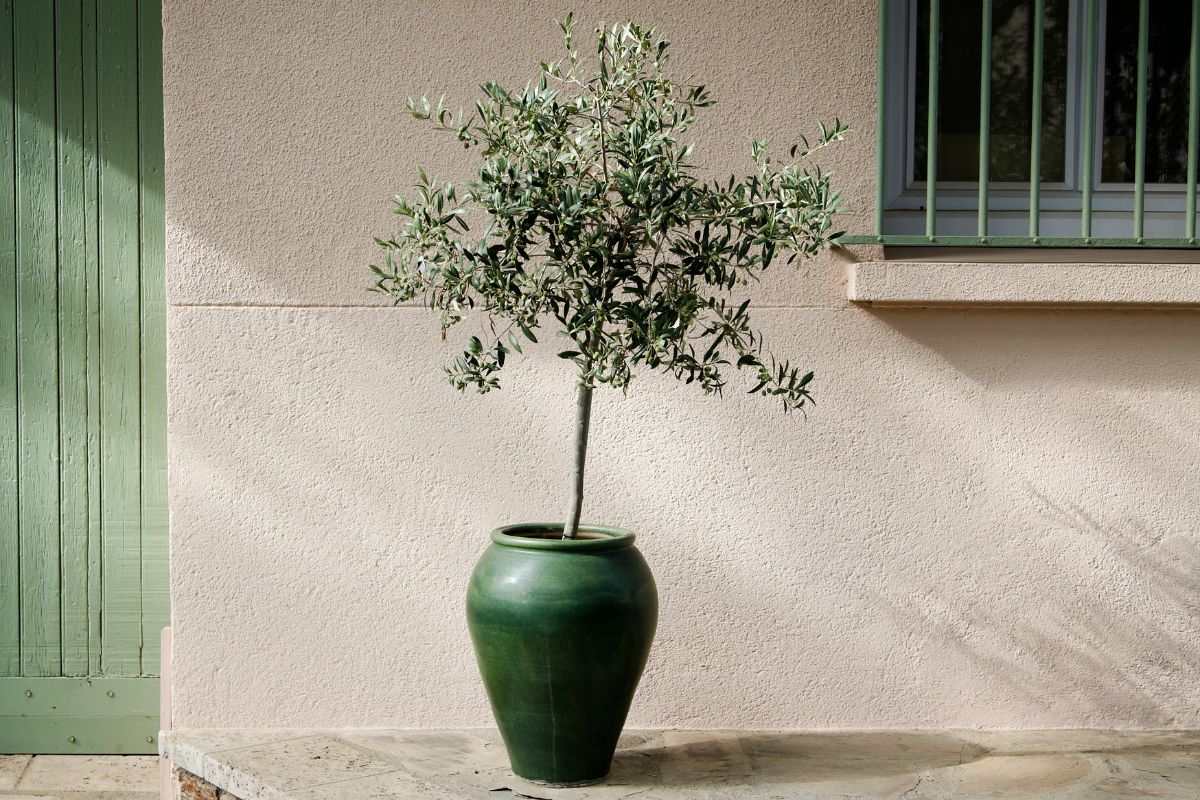
If you’re interested in adding an elegant and slow-growing fruit tree to your container garden, consider an olive tree. These trees are well-suited for container growth and can provide an abundance of fruit with proper care.
To grow an olive tree in a pot, follow these guidelines:
- Choose a dwarf or semi-dwarf variety, as full-sized olive trees can grow too large for a typical container garden.
- Ensure the pot is at least 16 inches in diameter and has ample drainage.
- Place the tree in a position that receives full sun, as olive trees thrive with plenty of sunlight.
- Water the olive tree consistently, but not excessively, to prevent waterlogged soil.
By paying attention to the specific needs of each type of fruit tree, you can successfully cultivate peach, lemon, and olive trees in your container garden. Enjoy the bounty of fresh fruit and the beauty of blossoming fruit trees right in your own space.
Additional Large Pots Planting Options
Besides the trees mentioned above, you can also consider growing other types of plants in large pots for a lush and thriving container garden. In this section, we will cover low maintenance herbs that can thrive in containers, adding diversity, and fragrance to your patio or outdoor space.
Low Maintenance Herbs
Herbs are wonderful choices for container gardening as they are generally easy to care for and can provide you with fresh, flavorful additions to your meals.
Here are a few low-maintenance herbs that you can grow in your large pots:
- Mint (Mentha spp.): Mint is a hardy perennial that can easily outgrow its boundaries, so planting it in a container keeps it contained. It prefers well-draining soil and partial to full sun. Make sure to water consistently, but avoid overwatering.
- Rosemary (Rosmarinus officinalis): This evergreen shrub is drought-tolerant and loves the sun, making it a perfect fit for container gardening. Choose well-draining, sandy soil and let your rosemary dry out slightly between waterings.
- Thyme (Thymus spp.): Thyme is a low-growing, aromatic perennial that enjoys full sun and well-draining soil. It’s great for adding a cascade of foliage to container gardens. Water sparingly but consistently, letting the soil dry slightly between waterings.
When considering pot and plant size, remember these guidelines:
- Tree size: Make sure the tree or plant you choose fits comfortably in the available space in your patio or garden. Some herbs, like rosemary, can grow into large shrubs, so keep that in mind when selecting your plants.
- Container size: Choose containers for your herbs and other plants that match their expected size upon maturity. This will ensure they have enough room to grow, and the appropriate space for their root systems to develop.
By incorporating different plants like these low-maintenance herbs into your container garden, you will create a diverse and attractive outdoor space that caters to your tastes and preferences. As you tend to your container garden, remember to regularly monitor your plants’ health, water, and sunlight needs, and enjoy watching your garden grow.
